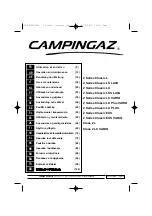
- 5 -
3)
Disconnect the plug from the power
source and/or the battery pack from
the power tool before making any
adjustments, changing accessories,
or storing power tools.
Such preventive safety measures
reduce the risk of starting the power tool
accidentally.
4)
Store idle power tools out of the reach
of children and do not allow persons
unfamiliar with the power tool or these
instructions to operate the power tool.
Power tools are dangerous in the hands
of untrained users.
5)
Maintain power tools. Check for mis
alignment or binding of moving parts,
breakage of parts and any other
condition that may affect the power
tools operation. If damaged, have the
power tool repaired before use.
Many accidents are caused by poorly
maintained power tools.
6)
Keep cutting tools sharp and clean.
Properly maintained cutting tools with
sharp cutting edges are less likely to
bind and are easier to control.
7)
Use the power tool, accessories and
tool bits etc. in accordance with these
instructions and in the manner intend
ed for the particular type of power
tool, taking into account the work
ing conditions and the work to be per
formed.
Use of the power tool for operations
different from those intended could
result in a hazardous situation.
Battery Tool Use and Care
1)
Ensure the switch is in the off posi
tion before inserting battery pack.
Inserting battery pack into power tools
that have the switch on invites accidents.
)
Recharge only with the charger speci
fied by the manufacturer.
A charger that is suitable for one type
of battery pack may create a risk of fire
when used with another battery pack.
3)
Use power tools only with specifi
cally designated battery packs.
Use of any other battery packs may
create a risk of injury and fire.
4)
When battery pack is not in use, keep it
away from other metal objects like paper
clips, coins, keys, nails, screws, or other
small metal objects that can make a
connection from one terminal to another.
Shorting the battery terminals together
may cause burns, or a fire.
5)
Under abusive conditions, liquid may
be ejected from battery; avoid con
tact. If contact accidentally occurs,
flush with water. If liquid contacts
eyes, additionally seek medical help.
Liquid ejected from the battery may
cause irritation or burns.
Service
1)
Have your power tool serviced by a
qualified repair person using only
identical replacement parts.
This will ensure that the safety of power
tool is maintained.
II
.
SPECIFIC SAFE
TY RULES
1)
Wear ear protectors when using the
tool for extended periods.
Prolonged exposure to high intensity
noise can cause hearing loss.
) Be aware that this tool is always in an
operating condition, since it does not
have to be plugged into an electrical
outlet.
3)
Hold power tools by insulated grip
ping surfaces when performing an
operation where the cutting tool may
contact hidden wiring.
Contact with a “live” wire will make ex-
posed metal parts of the tool “live” and
shock the operator.
4) If the bit becomes jammed, immediately
turn the main switch off to prevent an
overload which can damage the battery
pack or motor. Use reverse motion to
loosen jammed bits.
5) Do not touch the rotating parts to avoid
injury.
6)
Do not use the tool continuously for a
long period of time. Stop using the tool
from time to time to avoid temperature
rise and heat overload of the motor.
7) Do not drop the tool.
EY7411(UL).indb 5
2007/02/05 14:56:34






































